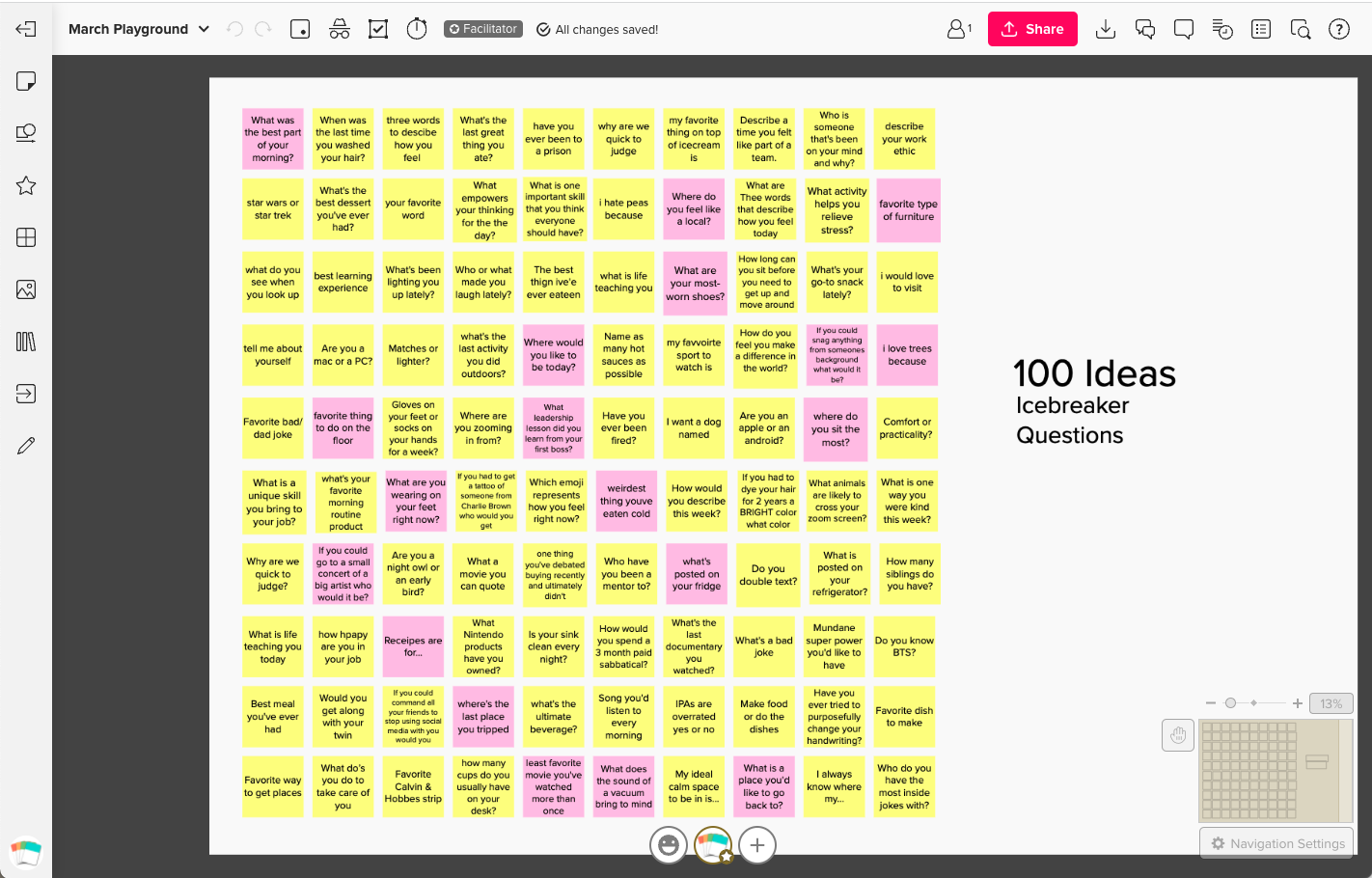When it comes to brainstorming, sometimes the most effective thing we can do as facilitators is to make the bar so low that you could trip over it, to steer people away from limiting themselves by only coming up with ideas they consider high quality.
That’s the theory behind the process 100 Ideas, and while it might seem a bit counterintuitive, this is one of those things where you shouldn’t knock it until you try it.
Before I ran this process, if you’d said to me, “Come up with 10 icebreaker questions that you like,” I would have told you that I don’t know if I could. Icebreaker questions are hard and I don’t often find myself coming up with ones I love on the spot (which is why I love tools like We Connect Cards—then I don’t have to).
But once I got into 100 Idea mode, coming up with 10 questions that I liked became totally doable. Here’s how it works.
How to Facilitate 100 Ideas
If you’re facilitating online, this starts with opening up a blank board on a digital whiteboard tool like MURAL, sending the link to your participants, and having everyone find their little corner of the board to work.
Then they write down as many ideas as they can. You want them to write their ideas down for whatever prompt you’re working on, one idea per sticky (this is the same for in-person facilitation). You might set a timer or pick a number they have to hit, but it’s all about the quantity of ideas, not quality.
When we facilitated this process at our recent Facilitator Cards Playground, our challenge was to generate 100 Ideas for icebreakers. We gave everyone in the group a challenge to come up with 15 icebreaker questions in three minutes. They didn’t have to be great ideas, or even good ideas! Bad, silly, unusable—all ideas were welcome!
Here’s what we learned about facilitating 100 Ideas.
Tips for Facilitating 100 Ideas
- Having each person have their own spot on the MURAL board is important to allow for more free-thinking and to reduce distraction. As soon as you see other people’s ideas, it can be easy to think, “Oh no, mine’s not as good,” which can make it harder to stay in the non-evaluatory mindset that is key to this activity.
- We’re so used to censoring or judging our answers that it takes a bit for people to move out of that mode and embrace whatever ideas come to mind. Additional prompting, emphasizing it’s only the quantity that matters, and even specifying or encouraging the group to write down their bad ideas, can help people let loose.
- The language of your prompt matters a lot. We think emphasizing the goal without evaluatory language is best. That might sound like, “The goal here is to get as many questions as possible, resist evaluation, we’re going for quantity over quality, they can be questions you’d never want to use, but just embrace whatever comes to mind!” Sometimes folks need the explicit invitation to let go.
- Be ready for tech issues. In our session, one person’s computer had trouble connecting to MURAL and another was on their phone. Our backup was to have them DM us their ideas and we added them to the MURAL for them.
- Bonus idea—run 100 Ideas as a competition! If you have a competitive group, challenge them to see who can come up with most in a 1-3 minute time range. If you have a more collaborative group, set a group goal where everyone is working to complete their part of the 100 Ideas (for example).
There are even more insights you can hear us discuss if you check out the recording!
Why We Love 100 Ideas
At first, the name seems a bit ridiculous. When would you need 100 ideas about the same thing? However, the process can really help get people out of their heads and into pure ideation mode. Evaluation is actually a killer of creativity, which is why you hear so many writers go on and on about writing crappy first drafts just to get it out there.
100 Ideas works with this logic and has surprised us every time with how many ideas we can come up with and how it allows us to ultimately think of good ideas we wouldn’t have come to any other way.
We would have never come up with questions like “where’s the last place you tripped?” or “favorite thing to do on the floor” for an icebreaker without the ticking clock and the encouragement to go go go, allowing our brains to just flow.
P.S.
You can see our 100 Icebreaker questions here!

